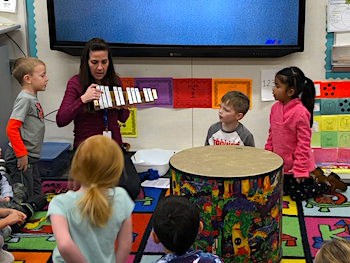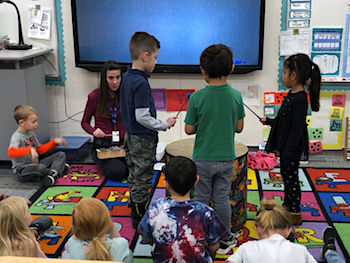SUBJECTS
GRADE
Show Results
Johnny Works with Place Value
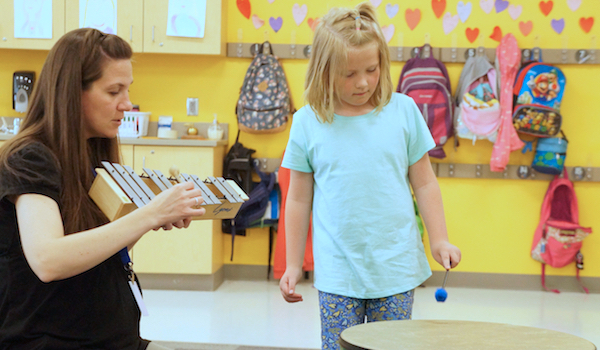
Lesson Summary
- Use musical instruments to teach place value.
- Sing and play the game “Johnny Works with One Hammer.”
Lesson Plan and Procedure
Lesson Key Facts
- Grade(s): K, 1, 2
- Subject(s): Math, Music
- Duration of lesson: 30-45 minutes
- Author(s): Emily Soderborg
Johnny Works with One Hammer
Play the singing game with students to introduce the song. (A clip of the music can be heard here.)
Game instructions:
Have students sit on chairs in a circle. (This game can also be played with students either sitting on the floor or standing, but both of these versions require more student coordination.) Sing the first verse, with students tapping one fist lightly on one leg, as if hammering. Keep all motions on the steady beat. In the second verse, when Johnny 
Teacher: I brought a drum with me today! The song lyrics say Johnny works with one hammer, but I have something besides a hammer to use today. This is called a mallet. Mallets are like hammers, but we can use mallets to help us play drums. If we used a real hammer on the drum, it would break the drum! Listen to the difference between the mallet sound and just using my hand. How would you describe the difference?
Sing the first verse and play on the beat to model for students.
Select one student to play a mallet on the drum while keeping a steady beat with the song. Set expectations with this student as the model. Praise the student for playing on the beat and treating the drum with respect. Sing the first verse again while the student plays.
 Teacher: Look how big this drum is. I wonder how many students we are going to be able to fit around the drum. . . .
Teacher: Look how big this drum is. I wonder how many students we are going to be able to fit around the drum. . . .
Encourage students to continue singing the additional verses. Add another student playing the same large drum, but with a new mallet for each verse. At the end of the fifth verse, instead of stopping, continue adding students, all the way up to nine students.
At the end of the ninth verse, when you sing, “Then he works with ten,” make a big deal about not having more room at the drum for any more students! If necessary, have students line their toes up around the edge of the drum, to show that more students will not fit without getting too squished. Have all nine students that were playing the drum sit back down.
Grouping Ten
Teacher: We need to find a new instrument to use. Look! This glockenspiel has ten bars on it! (Count the bars. The Fs and Bs on the glockenspiel should be removed to create a pentatonic scale.) We can show that we’ve counted to ten there. But this instrument is too small to have ten people around it. Instead of all ten of us playing, I am going to play all ten bars today. Even though we changed to a different instrument, it still shows how much we have already counted, but now we are grouping the ten notes together into one instrument, played by one mallet.
Note: Students will probably notice that some of the bars are removed. If they bring this up, you can tell them this is to create music that sounds good together, no matter what we play. If we add the other bars on, the sounds won’t work while we sing “Johnny Works with One Hammer.”
Explore the timbre difference between the drum and the glockenspiel. Have students share the differences they hear and see.
Teacher: Like a drum, a glockenspiel is also played with a mallet, but it has to have a different type of mallet than we used on the drum. How would you describe the sound differences between the drum and the glockenspiel?
(Possible ideas could include that the drum only plays one pitch while the glockenspiel plays ten pitches, and their sizes are really different [one is large enough to fit nine people around, while the other one is quite small.] One makes a sound that could be described as a banging sound. The other makes ringing or tinkling sounds.)
Teacher: How are the drum and the glockenspiel the same? (Possible answers could include that both instruments are played with mallets and both are in the percussion instrument family.)
Sing “Johnny Works with One Hammer” while playing accompaniment on the glockenspiel. (Remember, the Fs and Bs on the glockenspiel should be removed to create a pentatonic scale.) Play a C on the glockenspiel to give the class the starting pitch. (The note names are marked on the bars.)
Teacher (singing): One, two, ready, sing! (This will start everyone singing the song together.)
When the class starts singing, play a C again as the first note of the accompaniment, but then play any note on the glockenspiel, in any order. Keep a steady eighth-note pulse, matching with the initial rhythm “Johnny works with. . . .” However, make sure to play a C for the last note, so the accompaniment sounds finished.
Note: If students are not confident singing the song, adding a different accompaniment than the melody or basic beat may be too challenging. If they struggle singing while the various notes in the glockenspiel accompaniment are playing, simplify the activity by only sliding the mallet across the glockenspiel bars on the strong beats. This is a music standard that might need to be practiced more before the students are able to be successful. Adjust to where the students feel successful, but keep practicing so they can eventually achieve the higher levels of performance.
Teacher: We’ve sung Johnny up to ten today. But I think we could try 11. . . . There aren’t any more bars on the glockenspiel, but we have room on the drum again! Let’s put one person there, so we have a group of ten plus one more, which equals . . . 11.
Keep going until all the students in the class have had a turn to play on the drum. When you get to 20, use a second glockenspiel.
Teacher: As we played the drum, we were representing the ones. Ones are a single unit or object up to nine, and we showed that by each person having their own individual mallet. When we got to ten, I played the glockenspiel to show we had one group of ten. I didn’t have to count each individual bar on the instrument every time I played it, because we already knew it was a group of ten. When I say “tens,” that means a group of something with ten parts or units, just as our glockenspiel has ten bars.
Identifying Tens and Ones
Have students gather at the carpet. Model for students how to recognize place value of two-digit numbers using the instruments. Say a number out loud. Slide across (glissando) the glockenspiel bars for each group of ten, and beat the drum for each additional one, while counting out loud by tens and then counting on by ones. After using the instruments, tell how many groups of ten were in the whole number and how many individual ones were. Finish the process by repeating the number again.
As you play the instruments, have the students slide one hand across the floor for each ten and tap the floor with one finger for the ones. The students should count out loud while the teacher plays the instruments. For each number, always say the whole number first; then, after performing each number, say, “____ tens and ____ ones equals ____” (the whole number).
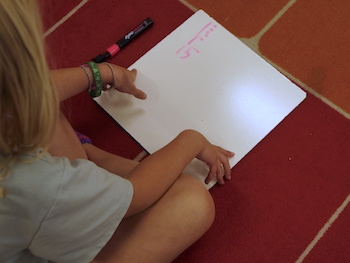
Play several numbers with students counting out loud and sliding and tapping their hands on the floor when the instruments play (15, 6, 60, 18, 2, 30, etc.). By having students move their hands in specific ways for tens and ones, they are creating muscle memory as well as utilizing a movement they can use at any time to help them keep track of numbers.
Double-check student understanding by having them just listen and show the number played on their individual whiteboards. Use the following numbers: 15, 8, 20, and 41. Have them utilize the quick-draw method by drawing tens on their whiteboards as lines, and ones as dots or small circles, and then finish by writing the number. Say the number out loud as a class and say, “____ tens and ____ ones equals ____” (the whole number).
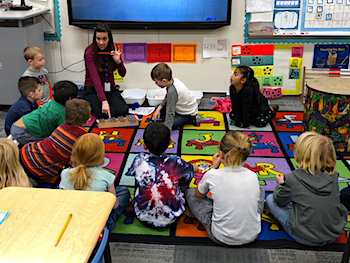
Extension: Challenge the students to figure out how to play the singing game for “Johnny Works with One Hammer” with enough body parts to go up to ten. One way they can do this is by using parts of the body that bend: wrists (two), elbows (two), ankles (two) waist, neck, knees (two). It’s challenging for them, but it’s so fun to see them moving every part of their bodies.
Second-Grade Hundreds Column Extension
In second grade, continue by introducing either an autoharp or a piano as a new instrument for the hundreds column. Neither of these instruments has exactly 100 notes, but they do have a lot more options than the glockenspiel has. Both of these instruments have strings, so they have a very different timbre from the glockenspiel and the drum. When singing “Johnny Works with One Hammer,” play the chords listed in the attached sheet music. (The autoharp has buttons that have the chords labeled on them, so it is the easier of the two options, if available.) As you play numbers above 100, have students put one hand flat on the floor for the hundreds movement. They will still slide for the tens and tap a finger for the ones as they listen. For a quick draw, they will draw a square for the hundreds, a line for the tens, and a dot for the ones.
Alternative Instruments
If actual instruments are not available, there are alternative options for each of the instruments listed in the “Equipment and Materials Needed” section.
Learning Objectives
- Understand that the two digits of a two-digit number represent amounts of tens and ones.
- Compare different timbres of instruments.
- Play on the steady beat.
- Sing in tune.
- Sing a song with a different accompaniment than the melody.
Utah State Board of Education Standards
This lesson can be used to meet standards in many grades and subject areas. We will highlight one grade’s standards to give an example of application.
Grade 1 Mathematics
- Standard 1.NBT.2: Understand that the two digits of a two-digit number represent amounts of tens and ones. Understand the following as special cases:
- 10 can be thought of as a bundle of ten ones, called a "ten."
- The numbers from 11 to 19 are composed of a ten and one, two, three, four, five, six, seven, eight, or nine ones.
- The numbers 10, 20, 30, 40, 50, 60, 70, 80, 90 refer to one, two, three, four, five, six, seven, eight, or nine tens (and 0 ones).
- Standard 1.MP.4: Model with mathematics. Identify the mathematical elements of a situation and create a mathematical model that shows the relationships among them. Identify important quantities in a contextual situation, use mathematical models to show the relationships of those quantities, analyze the relationships, and draw conclusions. Models may be verbal, contextual, visual, symbolic, or physical.
- Standard 1.MP.7: Look for and make use of structure. Recognize and apply the structures of mathematics such as patterns, place value, the properties of operations, or the flexibility of numbers. See complicated things as single objects or as being composed of several objects.
Grade 1 Music
- Standard 1.M.P.2: Explore the effects of various timbres, dynamic levels and tempos, using voice, movement, and simple instruments.
- Standard 1.M.P.3: Develop techniques and concepts to refine work for presentation by:
- Develop techniques and concepts to refine work for presentation by singing a variety of simple songs.
- Performing a rhyme or song with one rhythmic ostinato.
- Standard 1: M.R.1: Listen to and interact with a variety of contrasting music while recognizing steady beat, repeating patterns, and expressive elements.
- Standard 1.M.CO.1: Describe how music relates to personal experience, use life experience and additional content knowledge to inspire and respond to music, and deepen understanding of another content area through music.
Equipment and Materials Needed
- “Johnny Works with One Hammer” song sheet and game instructions PDF
- 22-inch gathering drum, frame drum, or hand drum (a smaller drum will work, but it might be a little bit squished), or a table or desk of the same size
- Nine drum mallets (appropriate for whichever drum you are using; most likely soft or rubber mallets, but if drumming on a table, you might need rhythm sticks or drum sticks)
- Glockenspiel(s) or xylophone(s) (or possibly tone bells) with B and F bars removed or marked so the instrument only has ten bars (these ten bars will play a pentatonic scale, which means you can play any combination of notes at the same time and they will sound good together; the notes should be C, D, E, [F removed], G, A, [B removed], C, D, E, [F removed], G, and A)
- Here is a free download for a PowerPoint virtual xylophone: https://www.teacherspayteachers.com/Product/Virtual-Xylophone-for-PowerPoint-2778463 (the GarageBand app also has a glockenspiel in the Toy Box sound effects pack, but this doesn’t have the option of removing bars to make it pentatonic)
- Mallet(s) for barred instrument (hard mallet for glockenspiel/soft mallet for xylophone)
- Optional for second grade: Auto harp or piano (you could also use the GarageBand smart piano or smart guitar settings to play the chords shown in the music)
- Individual whiteboards and dry-erase markers for each student
- Place-value math manipulatives (optional)
Additional Resources
- This lesson is part of a unit using the arts to teach place value. The lessons can be found on the BYU ARTS Partnership website. The titles include the following:
Image References
Image 1: Dianne Amesse.
Images 2–7: Lisa Garner.

www.education.byu.edu/arts/lessons
 Download
Download